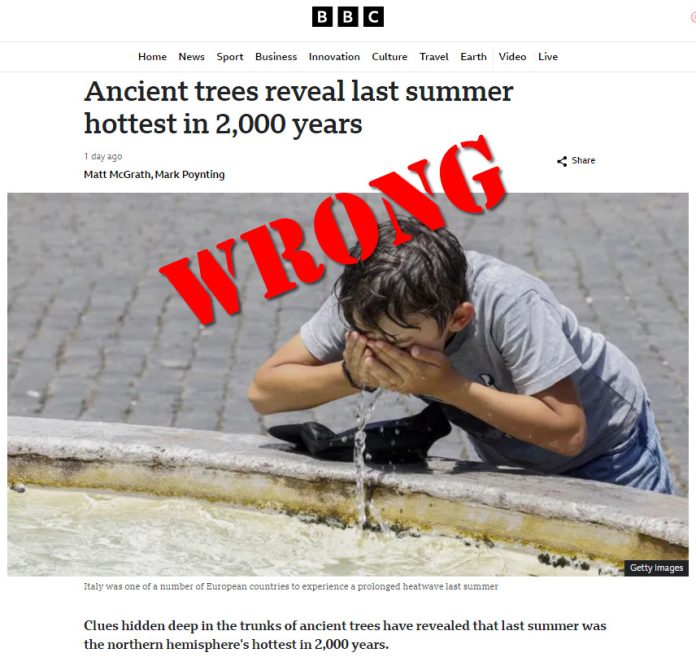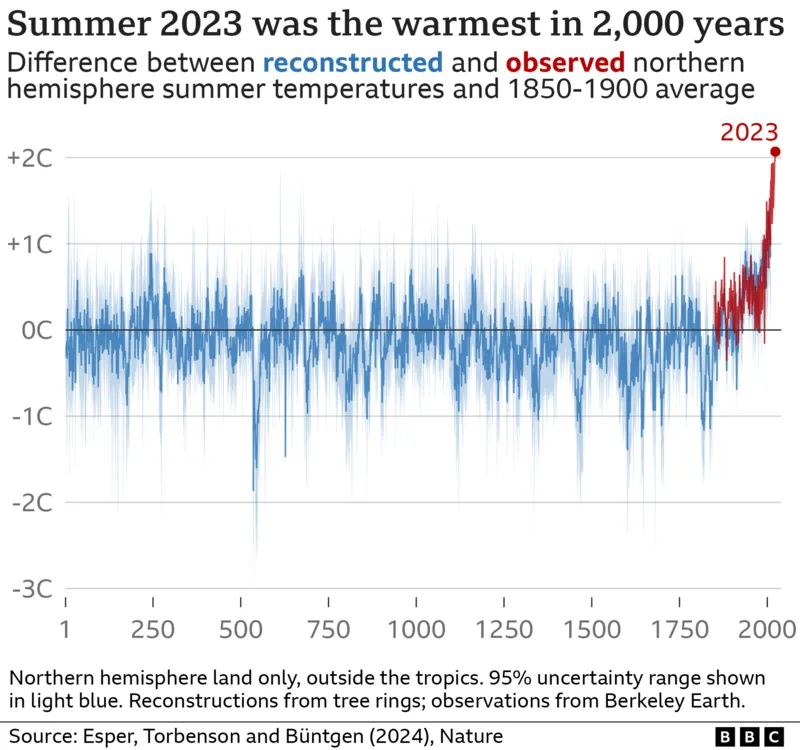Dozens of media outlets such as ABC News, The BBC, The New York Times, and many more, hyped a study that claims summer temperatures in 2023 were unprecedented over the past 2000 years. This claim, in fact, can’t be verified by tree ring data, which isn’t that precise. Researchers are falsely assuming tree rings are reliable temperature indicators when in fact tree rings can indicate a multitude of different conditions, not just temperature.
Further, the study, Esper, J. et al., Nature, 2024, is using an old trick, pioneered by Michael Mann, Ph.D. in his controversial hockey stick graph, where estimated temperatures from select tree rings and other proxies far into the past are grafted onto more reliable temperatures, measured in the present, and presented as one unified dataset, when in fact they are radically different.
For example, the BBC’s article about the study presented this graph, which is highly reminiscent of Mann’s original “hockey stick” graph.
That graph is highly misleading, if not a flat-out fabrication. It suffers from the same sort of issues in Mann’s original “hockey stick” graph, such as the fact that tree ring data from other trees show no such trend. We know from other studies that the Roman Warm Period (from 1–250 AD) and the Medieval Warm Period (950 to c. 1250 AD) existed, but they have been erased from this graph presented to the public as accurately representing past temperatures, when it is actually dishonest fiction based on a biased analysis of selected proxy data.
The fact that these well-known, documented, and scientifically certified climate events have been removed from the graph touted by the media indicate that this is more likely propaganda in pursuit of a political goal, rather than a scientific search for understanding based on honest use of the scientific method.
Another issue with the study is the well-known fact that annual tree ring growth is not tied solely to temperatures, much less the made up metric of “global average temperature,” as Liebig’s law of the minimum explains. Often simply called Liebig’s law, or the law of the minimum, is a principle developed in agricultural science by Carl Sprengel (1840) and later popularized by Justus von Liebig. It states that growth is dictated not by total resources available, but by the scarcest resource (limiting factor).
In other words, plant growth factors from year to year such as sunlight, available water as rainfall, available nutrients in the soil, and temperatures, among other factors, combine to determine growth of a tree, not just temperature alone. It is impossible to distinguish and disentangle the various factors that contribute to tree growth in any given year, much less thousands of years in the past. As a result, one can’t honestly claim that tree growth rings necessarily reflect temperatures alone at a particular time or location, much less that tree rings from one or a few sampled areas show anything about global temperatures or conditions. Making such claims is simply dishonest.
Also, that present temperatures may or may not be warmer than any in the last 2000 years says nothing about whether that is necessarily a bad thing. Historical evidence, in fact, strongly indicates that warmer periods are better for life and human civilization than cooler periods. The authors of this study, assume, without evidence, that just the opposite is the case.
The lead author, Jan Esper, confirms in the interview he gave the BBC that he is, in fact, using this study as a vehicle to elicit policy action:
The authors say the key conclusion from their work is the need for rapid reductions in emissions of planet-warming gases.
“The longer we wait, the more expensive it will be and the more difficult it will be to mitigate or even stop that process and reverse it,” said lead author, Prof Jan Esper from Johannes Gutenberg University, in Germany.
“That is just so obvious,” he said. “We should do as much as possible, as soon as possible.
This admission strongly suggests that the study is more about climate advocacy than science, and the media fell for it. This sort of journalistic malfeasance has become increasingly more common. The study’s authors are acting as advocates not scientists, a path the editors and fact checkers that media outlets employ followed as well in publicizing the report’s unverifiable claims and its authors’ calls for action. If they were actually doing their jobs as journalists to report the truth, the findings of this study never would have been promoted so widely, or if it had been, the writers would have balanced the story with the views of analysts critical of the study, citing scientific evidence.



















I followed the defamation case brought by Michael Mann against Mark Steyn and Rand Simberg in the US courts earlier this year, where credentialed and experienced defence witnesses made similar critiques of Mann’s ‘Hockey Stick’ theory.
They also stopped just short of claiming Mann’s thesis was fraudulent, but were quite clear that he stretched credulity in how he interpreted the data used to support the ‘hockey stick’
Reading Steyn’s book, which is a compendium of near verbatim accounts from dozens of scientists who disagree with Mann, two things are clear. Firstly the Science is not “settled”, and secondly there is a lot of politics in play.
As a Consulting Arborist and lecturer, tree rings can also develop based on movement and loading forces they experience. It’s called “thigmomorphogenesis”. How plant cells respond to mechanical stimulation.
Tree ring width can vary based on the movement caused by mechanical forces (including wind, ice and snow. and the mass of the tree itself). There is “tension” wood, “compression” wood, and “opposite” wood. Dr. Frank Telewski (retired) from Michigan State did extensive research on this.
Depending on where a wood core is taken can influence what is seen. Was the wood core from tension wood, or opposite wood, etc.
Tree ring growth analysis likely does not take this into account. Another “gap” in their knowledge that makes their conclusions even more suspect.